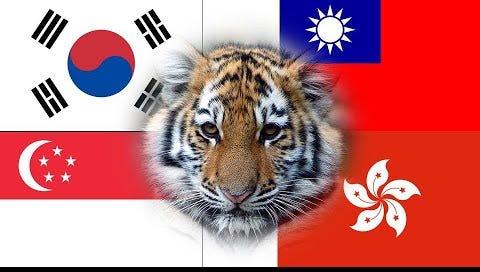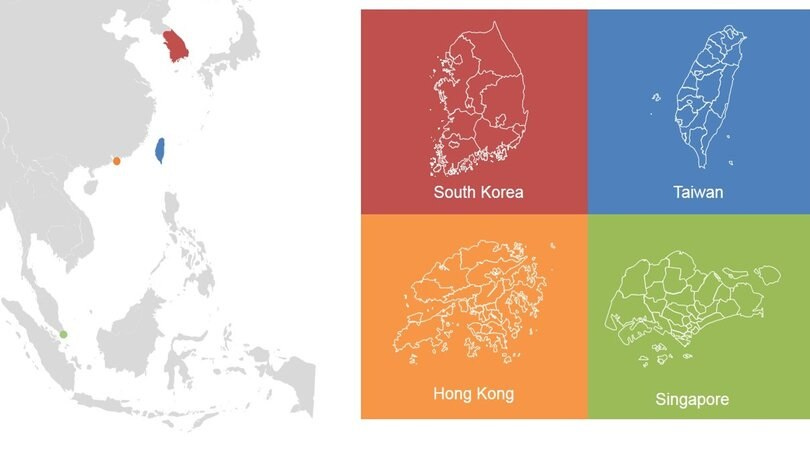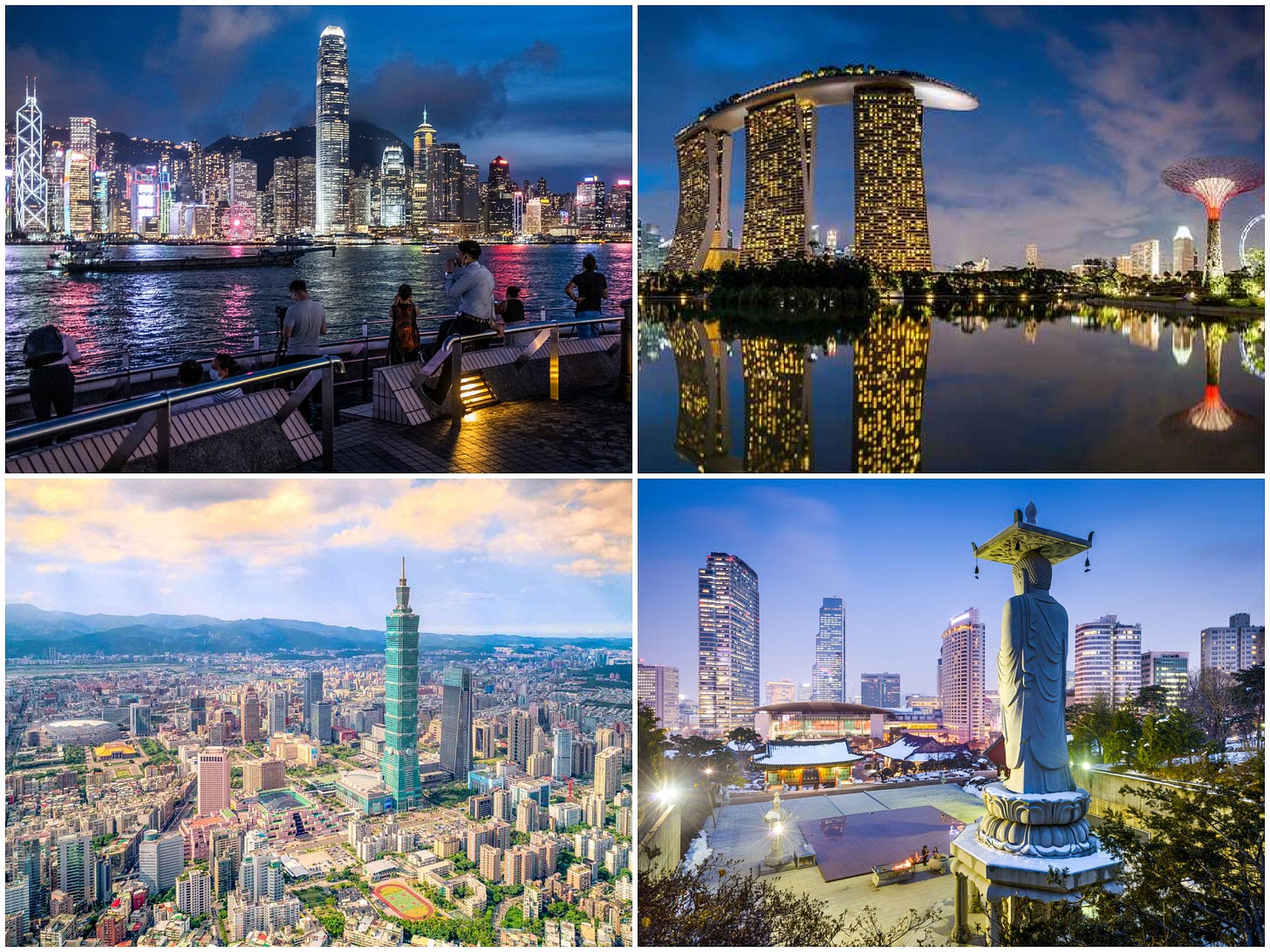In the late 1980s I went to grad school at UC San Diego for a Master in “Pacific International Affairs”. The School name has been changed since (now it is School of Global Policy and Strategy), but it was a new school focused on the growing Asian International Economic and Political Sector. One of the areas we investigated was the economic success of the “Asian Tigers.”
Note: For the purposes of this article, the four Asian tigers will be referred to as “nations” not “countries”. Hong Kong was a special district under British rule during this period and is currently a special district of China. Taiwan meets the definition of nation, but not of a country.
What were the Asian Tigers?
The Asian Tigers were the four nations that had made massive economic progress from 1960 – 1990. The growth from 1960 to 1990 in GDP is expressed in the table below, with some other representative countries’ growth numbers for comparison.
As you can tell from the growth chart, particularly in GDP per person, these four countries stand out as growing rapidly during this period, particularly compared to other similar nations. In investigating the Asian Tigers what factors caused this growth and can it be successfully mimicked.
What was Unique about Tigers?
They questions that research looked was as follows. What resources did the Tigers have or promote that were different from other nations? And which of these qualities could be shared as part of a successful path to growth? Upon investigation there were a set of common enablers for all four, although no two nations were exactly the same.
Clear and Established Legal Systems
The first thing that stood out as common between all four was a binding, consistent, and fair legal system.
Hong Kong and Singapore both were established as British Territorial administrative districts. These two nations were the colonial headquarter cities that had long been the administrative focus of laws and disputes. As for South Korea and Taiwan, both needed United States economic and military support, and had to implement a set of laws to enable US integration into their national legal system.
Importantly, once a law had been established, it was followed. Many countries have laws that regulate corporate actions, but then do not enforce them. These four nations followed the laws regardless of possible harm to local companies or individuals. This is more unusual than it sounds. Many nations, like Hungary and Poland, have laws protecting property or commerce that are ignored when it harms local industry. Other nations like the United States and Israel, have laws that regulate the conduct of their politicians, but they do not uphold or prosecute violators.
In the four Asian Tigers, the laws were mainly honored. Singapore and Hong Kong led the way on the impartial implementation of laws. In Taiwan, laws governing institutions and politics started changing in the 1970s, as the nation focused on internal governance instead of regaining mainland China. South Korea also passed and implemented laws governing commerce and industry that were followed. Political laws were not completely followed until the 1990s as the nation was run by a military dictatorship.
A Dominate Political Hierarchy
On investigation Tigers during this period had did have an unexpected common thread – at least unexpected to me. All four of these nations were under one party control through most of the period from 1960 – 1990. Singapore and Taiwan were organized under benevolent strong men. South Korea was a military dictatorship and Hong Kong was led by a succession of British controllers.
Because all four nations were focused on economic growth, a consistent and powerful government was effective for rapid growth. It is not the outcome we wanted to accept, but it did seem a positive for growth – not a negative.
Little Corruption
Despite the one-party environment of the nations, there was surprisingly little corruption. This is not to say there was no corruption, particularly economic gifts to cronies. But the widespread corruption of other countries, particularly newly independent countries, was not displayed. Even the military governments did not tolerate much corruption, outside of the traditional kickbacks.
Education
In all 4 nations, education was promoted both by the state and by the local cultures. Mandatory and free education was delivered across the nations. The education and literacy rates grew dramatically starting after World War II. In the 1960s this was not common across newly independent countries. Under colonialism, education of the indigenous population was not a priority. Schools and Universities were established, but often not available to locals. Political independence did not change this system in many newly created nations.
Private Ownership of Capital
In all the nations, the private sector was nurtured and supported. This was accomplished in different ways. South Korea supported Chaebols, vertical industries where supply chains were interconnected and owned, often maintained by families. Taiwan and Singapore nurtured private industries, and Hong Kong had culture of private ownership.
The nations did often put in place some limits to freedom of these private industries. For example, they did not control newspapers or magazines, but they often censored ideas they did not like. They also often focussed and supported growth in some industries. This resulted in some companies and industrial sectors being temporarily protected until they were profitable.
These nations also made it difficult for multinational corporations to purchase or take over local companies. Instead they fostered links and joint ventures for many foreign companies.
Differences from Similar Nations
Aside from these Asian Tigers, many other ex-colonies gained independence between the end of World War II and 1960. Since the colonial powers, primarily the UK, France, and the Netherlands, were busy rebuilding their own countries, very little support was given to the newly formed governments.
Lack of proper institutions and institutional memory left some of these countries very susceptible to poor government and corruption.
Lessons Learned
The point of understanding how the Asian Tigers succeeded was not for general knowledge. The ideas and implementations found here were used in various situations. It is also interesting how various international players have spun the success of these countries.
United States Message
All these nations were under some form of United States and/or British protection. Therefore, the thinking goes, while their defensing spending might be high (Taiwan in particular) none of their defense budgets were nearly as high as they would be without defense guarantees. By providing military confidence the countries will keep spending and budgets low. As a by-product, these countries were dependent on the United States for military support.
The United States also understood that increasing wealth in these nations was win for both sides of the trade. These nations were now lower cost exporters while simultaneously richer customers for US goods. The increase in worldwide wealth is not limited, but as it grows internationally, it also grows for American exporters and consumers, as well as our allies economy. (This message has since been challenged by Trump-ish Republicans in the United States, who see trade as a zero sum game.)
Many other countries tried to follow all or parts of this implementation, but failed. Sometimes because one or more areas were deficient. Sometimes a change in government, or the threat of one, stopped those implementation steps that were painful.
Chinese Message
In three of these nations, the Chinese communities lead the economic growth. The communities all helped to implement capitalism, without major changes in the governments. China itself followed this model starting in 1976 when Deng Xiaoping became leader after the death of Mao.
The Asian Tiger’s process was touted by China as a major success story for managed economies. Chinese also postulated that because all four nations were under a type of strong-man rule for many of these years of growth, a capitalist system could be separated from the political system.
Eastern European Lesson Learned
I have focused on the years from 1960-90 for two reasons. First, these were the years of massive growth. Second, these improvements came to fruition just as the Communist governments in Eastern Europe fell. (Third, I went to grad school in 1989 / 90.) This dynamic growth period led experts to try applying the lessons from the Tigers to the new ex-Communist nations.
The most famous of these people was Jeffery Sachs, who’s work in Poland was copied all over the region. Glossing over some details that differed from nation to nation, the general ideas were these.
1. Eastern European countries already had good education systems in place and were starting from a better spot that the Tigers early on.
2. Eastern European countries had much of the required legal framework in place, even if it was selectively enforced. The countries had already replaced many of the Soviet style judges with new judges from the democratic opposition. Better legal control seemed on the way.
3. Eastern European countries did NOT have private business ownership. And so the questions that caused arguments in the international development support community. How do you privatize a nations economy when there is almost no private property?
What was deemed necessary was to move the major state organizations into private ownership which did not defer decisions to the state. To do this, Sachs proposed a “big bang” of privatization via selling companies or pieces of companies. These changes were first implemented in Poland. Where a short-term economic downturn recovered and then the economy grew. This process and outcome followed in most of Eastern Europe.
Where it didn’t work
Countries with higher level of corruption
The “big-bang” was also used in Russia, Belarus, Ukraine and the ex-Soviet countries in the Asian region. However, in most of these countries, the leaders did not transition to more open governmental systems. Their “big-bang” initiatives ended up moving profits from the state into private control by political allies, or the country itself took control of ex-Soviet companies. This system propped up the ruling leaders, who rarely gave up control.
Summary
These lessons learned from these nations have been implemented in many other countries to some level. For most countries that were able to implement them fully, growth came quickly and widely after some hiccups. This includes countries like those of Eastern Europe, Ireland, Indonesia, Malaysia, Ghana, Vietnam, and India. Even partial implementation in places like China or Cuba sparked economic growth.
The blueprint from the implementation of these practices were memorialized as the Washington Consensus and are now seen as a viable path forward for developing countries or regions.
(I will critique the “Washington Consensus” later.)





